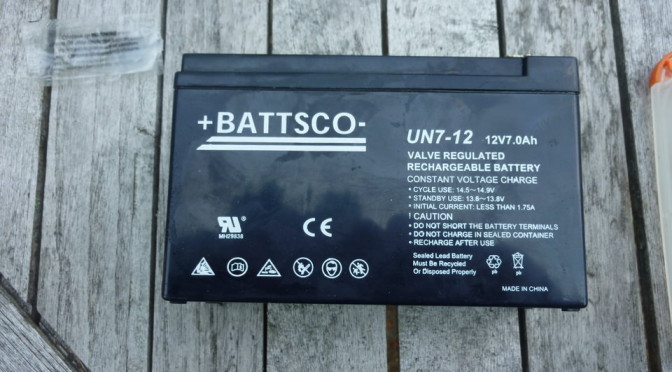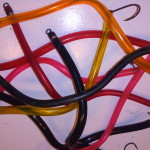Awesome new kayak for fishing? Check. Sweet fish finder? Check. Figured out the correct battery type and size to power the new rig? It’s not as straight-forward as it should be — picking a battery requires a small amount of basic electrical knowledge. But no sweat. It’s actually pretty simple. Here goes:
Basic Electronics
To choose a battery, we need to start with the absolute basic electronic concepts. Electrical power comes in two forms. Direct current (DC) is power generated by a battery, always flowing in the same direction (positive -> negative). This is the type of current needed by most fish finders, so we’ll be focusing purely on that. However, for completeness’ sake: alternating current (AC) is what powers your home, generated by a power plant. The current alternates directions 50-60 times a second and, without getting into too much detail, is easier to transmit over long distances.
When discussing electronics, there are four units to understand: voltage (volts), current (amperes), resistance (ohms), and power (watts). The easiest way to grasp these is to think of them in terms of plumbing. Voltage is like the water pressure, pushing water into the pipes. Current is similar to the rate of flow within the pipes (gallons per min., etc.). Resistance is like the size of the pipe itself.
Power (watts) is a little harder to grasp. Think of it like water, coming out of a pipe, hitting a water wheel and causing it to spin. If you want the wheel to spin faster, you have two options. 1.) Increase the pressure coming out of the hose, hitting the wheel harder. Or, 2.) increase the quantity of water coming out of the house, spinning the wheel faster purely due to the extra water weight. Similarly, power is the product of the voltage and current (power = current X voltage).
Head spinning yet? To sum it all up, voltage = force, current = rate, resistance = transmitter size, and power = capability of the voltage and current.
There’s one final item to consider: battery capacity. When discussing smaller contexts, such as fish finders, this is usually expressed in “amp/hours” (Ah). Think of this as the cistern providing water to the hose. If the water is flowing at a specific rate, how many hours would the supply last? Similarly, if electrical current is being consumed, how long will the battery be able to supply power? We need a big enough “bucket”.
Fish Finder Power
Most fish finders need DC battery power. Typically, they require 12 volts (again, the amount of “pressure” exerted by the battery). But, technically, many fish finders can safely use as low as 10 volts and as high as 20. However, since 12 volt batteries are the most common, I’d recommend just sticking to them.
Most fish finder specifications will list the “current drain” in the manual or on the box. For instance, my Lowrance ELITE-4X HDI lists a current drain of “Typical: .75A”.
In other words, “typically” it’ll pull .75 amps of current per hour. Two things to note here: 1.) Some companies will list this in milli-amps (mA). 1000mA = 1A. So in this example, it might be 750mA. 2.) Lowrance is listing the “typical” (average) pull, as opposed to the “peak”. Traditionally, most companies will use the latter. For instance, the greatest amount of consumption on the Lowrance might be closer to .8-1.0A. If you have the average available, great. If not, it’s best to assume the “peak” when calculating your needs. Worst case scenario, you’ll end up with a few extra hours of fishing time… Ok, enough jibber jabber. What exactly does that mean? Well, it all comes down to how long you want the fish finder to last per outing. Keep in mind that higher battery capacity always translates to more physical weight. Personally, I try to trim down as much as possible when I’m out, even if the battery weight seems relatively minimal — every bit helps. So for my purposes, assume 8 hours is enough. That means I would need a 6 amp/hour (Ah) battery (.75A X 8hr = 6Ah).
Battery Types
Essentially, you have three choices here:
- Lead acid: No different than you car battery — acid, sealed-in. They’re inexpensive and easily recharged, but they’re also the heavier option.
- Rechargeables (lithium, NiMH, etc.): Much lighter than lead acid, but also much more expensive. They can also be more complicated to recharge, frequently requiring a special adapter.
- Alkaline (AAA, AA, A, etc.): Technically, you can use multiple battery cells at once in order to get the power your fish finder needs. However, I’d recommend skipping these. For example, most alkaline cells only produce 1.5V, so you’d need 8 of them to get the required 12V. Also, your amp/hours will take a huge hit — those 8 AAs will only give you about 2Ah. Further, these can’t be recharged and end up in the trash.
I almost always go with the lead acid. Even though it’s heavier, its small cost and ease-of-use trump the alternatives.
Specific Batteries
Many stores (Bass Pro, Cabelas, Gander Mountain) have 12V lead acid batteries specifically marketed for fish finders or other outdoor applications. But, unless you find them on sale, they’re overpriced. I currently use a simple 8Ah unit I found on sale at Frye’s Electronics for $20. But you can find several on Amazon for even less. Don’t get anything fancy — run-of-the-mill units will suit you perfectly.
7-8Ah
Battery Chargers
Keep ‘er simple. A charger, like the following, works perfectly and is usually less than $10: However, I already had a larger battery charger that I use for automotive and marine batteries. If you only need it for the kayak, they’re probably overkill. But, they’re definitely handy to have around for other applications. Here are some options on Amazon. There are also inexpensive options at Menards, Lowes, and Home Depot. Keep in mind that the amp rating on the charger describes how fast it’ll be able to charge your battery. Large values are convenient for quickly charging a car battery, but small values are more than sufficient for the kayak. Some guys/gals will also permanently install a charger unit on their boat/kayak. The small unit gets mounted somewhere out of the way, and the wires are permanently attached to the battery leads (in addition to the fish finder wires). Here’s an example:





Hi,
You forgot to mention unless you want to change your lead acid battery regularly you should never drain it to more than 50%, therefore double up on the capacity if you want some battery life. Litium chemistry batteries are the other way around, you can use close to the rating (Ah) of the battery.
You also forgot to mention Wh, that’s how you measure how much energy a battery has. A 12V 7Ah lead acid has 84Wh (12V X 7Ah = ) of which you can use 42Wh (84Wh/2 =42Wh), a 4cell 14.8V (actually 16.8V fully charged), 7Ah Li-Po has 104Wh of which you can use all. That’s almost 3 times the capacity !!!
Just though I should mention it. My friends carry around 7Ah and 12Ah lead batteries in separate bags. I keep my 5Ah, 14.8V Li-Po in my pocket for transport AND have more capacity.
Just my 2¢
Cheers,
Peter